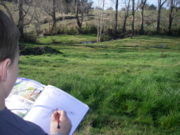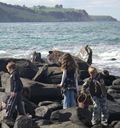Warrington School/Envirethical/Envirethical Nature Study
From WikiEducator
Envirethical Nature Study
Children and teachers, working together to find meaning, and interest in common things outside of the classroom
Objectives:
- The growth of children's minds and personalities through nature investigations by pupils
- To answer specific problems or experiments from personal observation of nature itself
Resources:
- Nature Study A Handbook for Teachers by D.Beggs and illustrated by R. Sharrell - published by R.E. Owen Government Printer Wellington 1955
- New Zealand Nature Study by Wm. Martin, B.Sc.Published by Whitcombe and Tombs Limited 1947.
We have chosen these books as the information and ideas contained, are as relevant today as they were 50+ years ago
How:
- Every second Wednesday from 1.30 – 2.50 as part of the enviro clubs option
- 14ish children and a teacher and another adult will use the School's walkable environs to study nature.
- The guiding methodology will be based on the ethics that are instilled into the text of "Nature Study A Handbook for Teachers” and "New Zealand Nature Study"
Equipment:
- The two adults will carry all equipment for the pupils - this will include:
- Exercise books for each child, plastic ground sheets, magnifying glasses, colouring pencils, nature identification books, Maori dictionary, map and compass, digital camera and binoculars
Invited to attend:
- Other nature interested or capable adult members of the community - such as gardeners, ornithologists, geologists
Session one - dead bird and paddock:
- Collect all children together share the study of nature and what this means to them
- List all the equipment we may need
- Talk about using the old nature study books and flora and fauna identification books
- Pack bags and head outside to look at an unidentified bird that was found on the beach and then frozen in shopping bags
- Look at the birds structure using a bird part identification chart and name its parts
- Looking and touching moving its wings and neck
- Walk to the school paddock, unpack the gear and hand out books, children to head off in all directions equipped for observing nature with exercise book and pencils
Kereru perching tree camera zoom strain, flax niibblers edge nicks middle gobble holes, water jumping skim stone fleas, duck flapping water splash, pack up time debrief.
Session two - pond:
- Make scoop nets from wire, sticks and pantyhose
- Pushing stretched wire coathangers up cut off panty hose legs then taping these onto the sticks
- Pre-check of site with adult assistant
- Meet owner and do visual check of site and point out dangers e.g cow and calf, deep ponds, steep banks and electric fence
Pond observation from wooden platform, kneeling with naked eye, view insect water life, insects moving above and below, surface tension feet, magnifying glass observe wrigglers big head upside down, scoop and glass jar, flick life forms from net, insect identification book, mosquito pupae larvae siphon, back swimmers, stream slime, duck dock feathers, iris and petunia; bovine mother and daughter
Session three - blossom:
- Discuss what is a flower, bloom and blossom
- Wander the school looking at flowers, picking selections and placing in a basket
- Warn about picking only single samples of flowers unless there is a large amount
- Locating varying sizes and make statements about similarities
- On the ground sheet lay all flowers out to view, discuss, cut up and place into flower press
Petal plucking numbering, sliced cross section, corolla sepal stigma, cardboard label squish, earwig invader, petal colour page smudge,cardboard floral layers,tighten wingnuts, sunny positioning, drying.
Flower Blossom Pollination Conifer
Session four: - rock pools
- Create a Ram Master
 for trip to the rocks, discuss its contents, laying out the risks that may be found and asking for other risks the students may know of
for trip to the rocks, discuss its contents, laying out the risks that may be found and asking for other risks the students may know of
- Gather all equipment, head count children and walk to the beach
- On the beach and rocks begin to look at treasures found and give basic understandings
- Compare bi-valves with uni-valves, limpets to chitons, male crabs with female crabs, plant to animal
- Use books to locate correct names of found creatures
- Magnifying glasses to look closer for hidden details and camera to record creatures that shouldn't be moved
Chiton limpet disagreement, cats eye recipe, mussel rock clinging, sea squirt animal disbelief, camera macro, rock pool treasures basket filled, schoolroom stench basket treasures rot.
Crabs Univalves Bivalves Chiton Limpet Sea Anenome Sea Squirts
Session four: - bugs and worms
- Scavenge the compost heap and worm farm for creature
- Discuss handling techniques
- Magnifying glasses to observe finer details
Wriggling worms, trembling fingers, eye to eye, screams, do insects have ears?
Earthworm Worm Annelida Worm Farm Worm Anatomy Worm Anatomy Dissection Slater Slater Anatomy Slater NZ
Other bits to consider
- Care code - themselves, others (including critters), environment
- Health and safety code - boundaries, suitable clothing, handling
- Gear - clothes, equipment
- Recording info to share
- Using the equipment
- In the hide
- Bird feeder
- Frog statistical study



